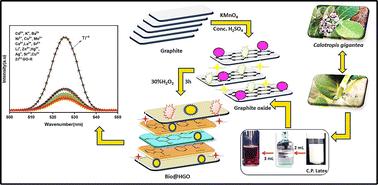A novel synthesis of hybrid graphene oxide as a dual-functional fluorescent chemosensor for Ti4+ ion detection and antibacterial performance via simultaneous oxidation and functionalization
IF 3.3
3区 化学
Q2 CHEMISTRY, INORGANIC & NUCLEAR
引用次数: 0
Abstract
Functionalized graphene oxide (GO), a versatile two-dimensional material, is synthesized by surface modification and exhibits remarkable physical and chemical properties, making it attractive for a wide range of applications. In this work, we present a unique one-step approach that simultaneously oxidizes and functionalizes graphite using Calotropis gigantea latex as a natural reagent. The latex functions as an oxidizing and functionalizing agent, introducing bioactive compounds and oxygen- and nitrogen-rich functional groups onto the GO surface under ambient conditions (Bio@HGO). This method minimizes the use of hazardous reagents and introduces a high density of surface functional groups on GO sheets suitable for metal ion interactions. The synthesized material was characterized using PXRD, FE-SEM, XPS, Raman, FTIR, and BET analyses to confirm the successful functionalization by using natural latex. The introduction of oxygenated and nitrogen-containing groups from Calotropis gigantea latex is found to improve dispersion stability and enhance the affinity for Ti4+ metal ion detection. Electrochemical investigations have confirmed that the material exhibits high sensitivity and selectivity towards Ti4+ ions, with a distinguishable and measurable response in the given experimental concentration range. This work highlights the potential of Calotropis gigantea latex-derived materials for the development of graphene-based sensors, offering a sustainable route for environmental monitoring of toxic metals such as Ti4+. In addition, the potential antibacterial activity of Bio@HGO was also confirmed against Pseudomonas aeruginosa and Escherichia coli bacteria, with zones of inhibition of 0.95, 1.57, and 1.90 mm and 1.25, 1.45, and 2.15 mm at 20, 40, and 80 μg mL−1 concentrations of Bio@HGO, respectively.

一种新型合成的杂化氧化石墨烯作为双功能荧光化学传感器,通过同时氧化和功能化来检测Ti4+离子并具有抗菌性能
功能化氧化石墨烯(GO)是一种通过表面改性合成的多用途二维材料,具有优异的物理和化学性能,具有广泛的应用前景。在这项工作中,我们提出了一种独特的一步方法,同时氧化和功能化石墨使用巨茶卡罗普斯乳胶作为天然试剂。乳胶作为一种氧化和功能化剂,在环境条件下将生物活性化合物和富氧、富氮官能团引入氧化石墨烯表面(Bio@HGO)。这种方法最大限度地减少了危险试剂的使用,并在氧化石墨烯薄片上引入了高密度的表面官能团,适合金属离子相互作用。利用PXRD、FE-SEM、XPS、Raman、FTIR、BET等分析手段对合成材料进行了表征,证实了天然乳胶功能化的成功。研究发现,从巨茶卡罗贝斯乳胶中引入含氧基团和含氮基团可以改善分散稳定性,增强对Ti4+金属离子的检测亲和力。电化学研究证实,该材料对Ti4+离子具有很高的灵敏度和选择性,在给定的实验浓度范围内具有可区分和可测量的响应。这项工作强调了Calotropis gigantea乳胶衍生材料在开发基于石墨烯的传感器方面的潜力,为有毒金属(如Ti4+)的环境监测提供了可持续的途径。此外,Bio@HGO对铜绿假单胞菌和大肠杆菌也有潜在的抑菌活性,在Bio@HGO浓度为20、40和80 μg mL−1时,分别有0.95、1.57和1.90 mm和1.25、1.45和2.15 mm的抑制区。
本文章由计算机程序翻译,如有差异,请以英文原文为准。
求助全文
约1分钟内获得全文
求助全文
来源期刊

Dalton Transactions
化学-无机化学与核化学
CiteScore
6.60
自引率
7.50%
发文量
1832
审稿时长
1.5 months
期刊介绍:
Dalton Transactions is a journal for all areas of inorganic chemistry, which encompasses the organometallic, bioinorganic and materials chemistry of the elements, with applications including synthesis, catalysis, energy conversion/storage, electrical devices and medicine. Dalton Transactions welcomes high-quality, original submissions in all of these areas and more, where the advancement of knowledge in inorganic chemistry is significant.
 求助内容:
求助内容: 应助结果提醒方式:
应助结果提醒方式:


